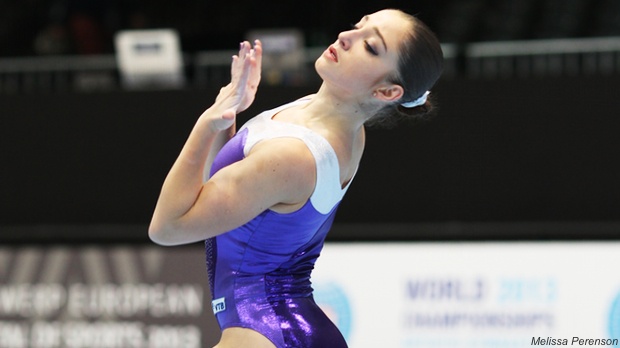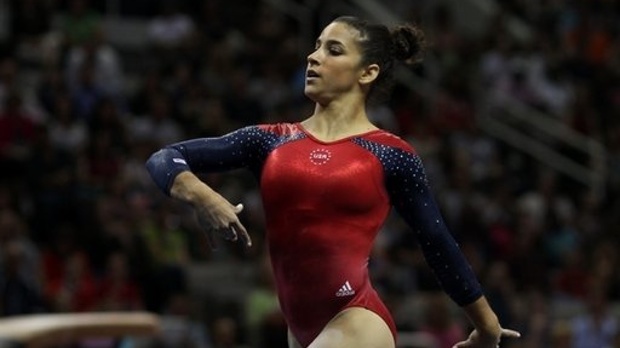Crafting a Floor Routine: An Analysis of the D-Score
Crafting a Floor Routine: An Analysis of the D-Score
Crafting a Floor Routine: An Analysis of the D-Score

In the second part of our series on D-score analysis, we’re taking a look at floor exercise, historically one of the toughest judged events in women’s elite gymnastics. A step here, a flexed foot there, and a gymnast can find herself with deductions adding up quite quickly. Consequently, it’s to the gymnast’s advantage to bump up her difficulty level as much as possible.
Floor is actually similar to balance beam in the D-score makeup. Below I’ve explained all the details and the various ways a gymnast can increase her difficulty on floor.
The “Must Haves”
As with beam, floor has a list of Composition Requirements (CR). The gymnast must include a dance passage, composed of two different leaps or hops, one of them reaching a 180 degree split. For acrobatics, the gymnast must perform a forward or sideways salto in addition to a backwards salto. They must also include a salto with at least a full LA turn (longitude axis - think an arabian or full twist), and a salto with double BA (breadth axis or somersaulting rotation - think a double back pike or double back layout). They also must include a dismount (final tumbling pass) which is at D-level or above to get full points (D-skill examples include a double back tuck or pike, a backward 2 ½ twist, or a forward double twist).

The Magic Number 8
Again, similar to beam, only the top 8 (top meaning the highest valued elements) skills are counted in the difficulty score. As a reminder, elements are assigned a letter value from A to H, with A being the lowest value at 0.10 points, and H being the highest at 0.80 points.
It is important to keep in mind that it is not just tumbling that gets rewarded with high marks - this is true on beam and it’s also true on floor. Remember Aliya Mustafina’s floor routine at Worlds in Nanning? She only included three tumbling passes instead of the standard four, but her difficulty level was still relatively high at 6.2, and this is because of the tough dance elements included in her routine. Depending on the individual gymnast’s strengths, she will craft her floor routine accordingly. Mustafina is particularly skilled in dance, and so she prefers spins to flips. Her quadruple spin (also known as a Gomez) is an E-level skill, worth the same amount as a full twisting double back tuck.
It is also important to note that a gymnast with powerful tumbling skills (think Shawn Johnson, MyKayla Skinner, and Simone Biles) cannot just tumble her way through her top 8 skills. Besides the fact that she’d have some real trouble catching her breath, the judges want to see dance skills included, so only a maximum of five out of the top eight skills counted can be acrobatic, and the rest must be dance.
Connect It for Brownie Points
Connection Value on floor is not as crucial as it is on beam, however it is still used as a source of bonus points for a gymnast’s D-score where possible. The most famous example of this is Aly Raisman’s opening pass from 2012 - round-off, 1.5 twist (C element), straight into round-off, flic flac, double arabian (E element), straight into a punch front layout (B element). The indirect C+E connection gave her +0.20, while the direct E+B connection gave her another +0.20, for a total of +0.40 bonus points - a huge amount for just one pass.

Putting it All Together - the Final D-Score
To help understand the makeup of the D-score on floor, take a look at Aly Raisman’s routine from the 2012 Olympic Floor Finals.
Aly’s routine, unsurprisingly, satisfied all of the CR. She performed a dance passage with her switch ring leap connected into a split leap with 1.5 turn, she satisfied the salto with LA with her triple twist, and she included a double pike to satisfy the salto with double BA requirement. Lastly, her dismount was a double pike, a D element.
Looking at the top 8 skills counted, Aly’s floor routine played to her incredible tumbling skills, so most of her difficulty points came from acrobatics. Her top 5 acrobatic elements were a double arabian in piked position (F), a double arabian (E), a triple twist (E), a double pike (D), and a 1 ½ twist (C). Her toughest dance elements were a change leg leap with full turn and a split leap with a 1 ½ turn, both D elements. She also competed a switch ring leap (C) for her final dance skill counted.
Besides the massive 0.40 Connection Value that Aly secured with her first pass, she also added an additional 0.10 from connecting her double arabian in piked position to a split jump, and another 0.10 from connecting her double pike into a split jump for her final pass. Total connection value for her routine was therefore 0.60.
Adding it all together, Aly had a total of 3.4 for her top 8 elements, and 0.60 for connection value. Combined with the composition requirements, her total D-score was 6.5.
Stay tuned for more D-score analysis on bars next!
Related:
Crafting a Beam Routine - An Analysis of the D-Score
Floor is actually similar to balance beam in the D-score makeup. Below I’ve explained all the details and the various ways a gymnast can increase her difficulty on floor.
The “Must Haves”
As with beam, floor has a list of Composition Requirements (CR). The gymnast must include a dance passage, composed of two different leaps or hops, one of them reaching a 180 degree split. For acrobatics, the gymnast must perform a forward or sideways salto in addition to a backwards salto. They must also include a salto with at least a full LA turn (longitude axis - think an arabian or full twist), and a salto with double BA (breadth axis or somersaulting rotation - think a double back pike or double back layout). They also must include a dismount (final tumbling pass) which is at D-level or above to get full points (D-skill examples include a double back tuck or pike, a backward 2 ½ twist, or a forward double twist).

The Magic Number 8
Again, similar to beam, only the top 8 (top meaning the highest valued elements) skills are counted in the difficulty score. As a reminder, elements are assigned a letter value from A to H, with A being the lowest value at 0.10 points, and H being the highest at 0.80 points.
It is important to keep in mind that it is not just tumbling that gets rewarded with high marks - this is true on beam and it’s also true on floor. Remember Aliya Mustafina’s floor routine at Worlds in Nanning? She only included three tumbling passes instead of the standard four, but her difficulty level was still relatively high at 6.2, and this is because of the tough dance elements included in her routine. Depending on the individual gymnast’s strengths, she will craft her floor routine accordingly. Mustafina is particularly skilled in dance, and so she prefers spins to flips. Her quadruple spin (also known as a Gomez) is an E-level skill, worth the same amount as a full twisting double back tuck.
It is also important to note that a gymnast with powerful tumbling skills (think Shawn Johnson, MyKayla Skinner, and Simone Biles) cannot just tumble her way through her top 8 skills. Besides the fact that she’d have some real trouble catching her breath, the judges want to see dance skills included, so only a maximum of five out of the top eight skills counted can be acrobatic, and the rest must be dance.
Connect It for Brownie Points
Connection Value on floor is not as crucial as it is on beam, however it is still used as a source of bonus points for a gymnast’s D-score where possible. The most famous example of this is Aly Raisman’s opening pass from 2012 - round-off, 1.5 twist (C element), straight into round-off, flic flac, double arabian (E element), straight into a punch front layout (B element). The indirect C+E connection gave her +0.20, while the direct E+B connection gave her another +0.20, for a total of +0.40 bonus points - a huge amount for just one pass.

Putting it All Together - the Final D-Score
To help understand the makeup of the D-score on floor, take a look at Aly Raisman’s routine from the 2012 Olympic Floor Finals.
Aly’s routine, unsurprisingly, satisfied all of the CR. She performed a dance passage with her switch ring leap connected into a split leap with 1.5 turn, she satisfied the salto with LA with her triple twist, and she included a double pike to satisfy the salto with double BA requirement. Lastly, her dismount was a double pike, a D element.
Looking at the top 8 skills counted, Aly’s floor routine played to her incredible tumbling skills, so most of her difficulty points came from acrobatics. Her top 5 acrobatic elements were a double arabian in piked position (F), a double arabian (E), a triple twist (E), a double pike (D), and a 1 ½ twist (C). Her toughest dance elements were a change leg leap with full turn and a split leap with a 1 ½ turn, both D elements. She also competed a switch ring leap (C) for her final dance skill counted.
Besides the massive 0.40 Connection Value that Aly secured with her first pass, she also added an additional 0.10 from connecting her double arabian in piked position to a split jump, and another 0.10 from connecting her double pike into a split jump for her final pass. Total connection value for her routine was therefore 0.60.
Adding it all together, Aly had a total of 3.4 for her top 8 elements, and 0.60 for connection value. Combined with the composition requirements, her total D-score was 6.5.
Stay tuned for more D-score analysis on bars next!
Related:
Crafting a Beam Routine - An Analysis of the D-Score